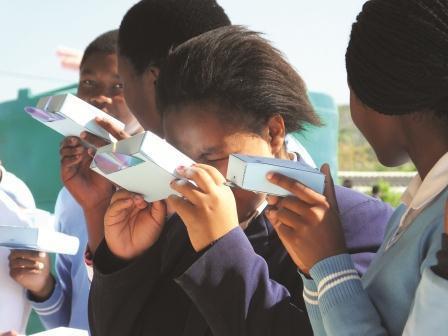Stephen Ashworth unlocks colour with a spectroscope and explains how to make your own in this article from our ‘Avogadro’s lab’ series
Christmas will soon be here and many of us will put up lights as decorations. The key to the wonderful lights and colours we see is the structure of the atoms and molecules that produce or filter light. We can, however, turn this on its head and use light to obtain information about the structure of atoms and molecules.
White light contains all the colours of the rainbow. If a substance absorbs no light (or absorbs all colours equally) all the colours reach our eyes and it appears white. If a substance absorbs all the colours completely, it appears black. Compounds that absorb some colours more than others are the ones that appear coloured.
In order to obtain detailed information about this light, we need to split it into its component parts, just like we see in a rainbow.
DVDs and spectroscopes
To split up light, we can build a scientific instrument known as a spectroscope. The main part of our instrument will be a DVD. The shiny surface of a DVD appears to be lots of different colours, which change depending on the angle you view it from. These colours are the result of an effect known as diffraction, and the DVD is acting as a diffraction grating.
The surface of a DVD has a series of microscopic pits where the data is stored. Between the pits, however, are smooth areas that act like very thin mirrors lined up with tiny gaps between them. The width of the mirrors is less than the wavelength of light. When light is reflected from these mirrors it spreads out in all directions – it does not just bounce off in one direction as it would from a larger mirror. The light spreading out from one mirror interacts with the light spreading out from the next-door mirror, so red can be seen at one angle and blue at a different angle.
Try it yourself
To make our spectroscope, the DVD needs to be put in to a special box. You can download a template for this box. It is best to make the box from thick coloured paper or thin card, to cut out as much background light as possible. Construct the box by cutting along all the dotted lines and folding along the solid lines. The box should have a slit in it, a small rectangular hole and a round hole.
Slide the DVD into the slot (it is not meant to go in all the way) with the shiny side towards the round hole. Point the rectangular hole at a light source, such as a light bulb, and look in the round hole as you would into a camera. You should be looking at the surface of the DVD and, if the slit is pointing in the right direction, the light coming through the slit will be split up into a rainbow.
Take a look
Fluorescent lights, like energy saving bulbs, contain mercury – you can use your spectroscope to examine the spectrum of visible light that is emitted. We can also examine the light from the sun that reaches the Earth’s surface. Do not point the spectrometer directly at the sun: you will get a much better and safer result by looking at the light coming from a white cloud. You will see a rainbow, but if you look carefully you will see some dark lines. These lines are caused by the atmosphere absorbing light between the sun and your spectroscope: helium was discovered in this way.

Did you know?
Crystals can be thought of as natural diffraction gratings – their chemical structures scatter electromagnetic radiation. This is the basis for the analytical technique known as x-ray crystallography, which is used for determining the atomic and molecular structure of a crystal.
Additional information
This article originally appeared in The Mole, the student magazine published by the Royal Society of Chemistry from 2012 to 2015.










No comments yet